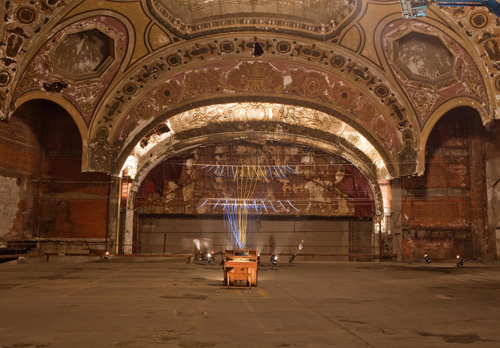Rediscovering Detroit's rich artistic and cultural heritage, and how it could revitalize the city.
Despite penning what was perhaps the first musical dismissal of flyover states, Talking Heads’ “The Big Country”, which ended with the refrain “I wouldn’t live there if you paid me to,” David Byrne has a fair amount of affection for the Midwest. Particularly the forgotten and destitute parts of the country, such as Detroit, which he examines in a fascinating blog post, “Don’t Forget the Motor City”.

In his post, Byrne references “Requiem For Detroit”, a documentary by British director Julian Temple which can be watched in its entirety on Youtube.
Byrne mounts a forceful defense of the scorned city, demonstrating that is it has been as much a victim of mismanagement and inattention as New Orleans after Katrina:
This is a city that still has an infrastructure, or some of it, for 2 million people, and now only 800,000 remain. One rides down majestic boulevards with only a few cars on them, past towering (often empty) skyscrapers…This process didn’t happen overnight, as with Katrina, but over many many decades. However the devastation is just as profound, and just as much concentrated on the lower echelons of society. Both disasters were man-made.
Byrne explores the history of the city, from its heady days when Henry Ford was the city’s wealthy benefactor up to the present day, marked by economic depression and dilapidation. In the process, he details the rich artistic and cultural heritage the city has contributed, often forgotten amid the many portrayals of Detroit as a dying city. And through the arts, he posits a way that the city could possibly rehabilitate itself:
Other cities have used culture to bring life back—Morris mentioned Bilbao—but to be honest, so much of Detroit is simply gone, vanished, that that kind of revitalization is hard to imagine. Bilbao was a smaller town, even if it was a dump. However, one can imagine that if the city center here can become more of the focus then a much smaller town with vibrant life might emerge. Forget much of the urban sprawl (or turn it into farmland) and see if the wonderful stuff can be encouraged and supported. Again, it could be arts and theater and music that spurs some of that—there were 3 movies and a TV show shooting when we where there; Matthew Barney was preparing a large scale performance involving molten metal not too far away, and local artists and musicians have always gone their own dark ways here—so the interest is there. The skies here are bigger than in New York.
While Byrne’s prescriptions for Detroit's woes are vague, he offers a compelling travelogue of a forgotten city, and the role art and culture can play a role in rehabilitating the economy. Is it a credible route? Hard to say, but it’s certainly more promising than hitching the city’s fortunes to a declining industry.









